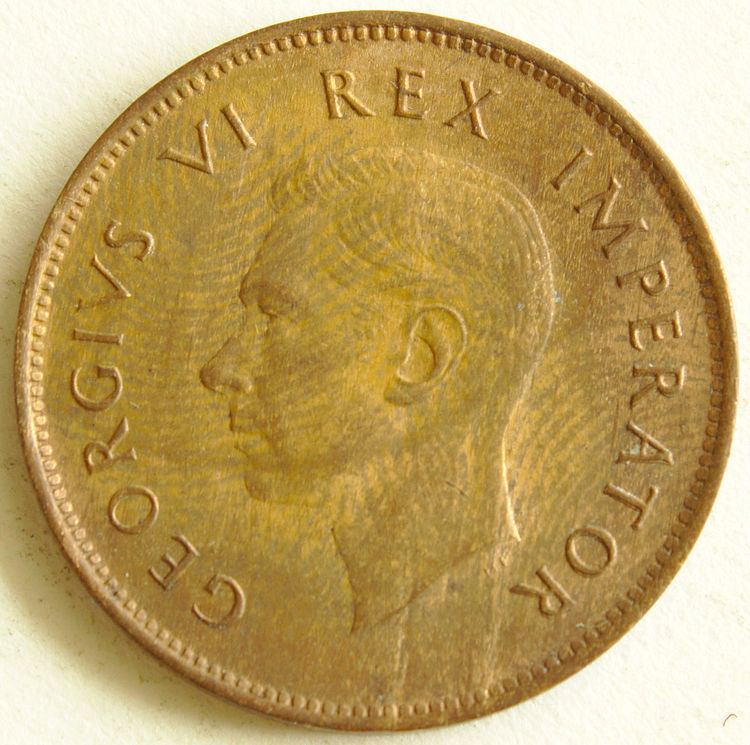 | ||
The coins of the South African pound were part of the physical form of South Africa's historical currency, the South African pound. Prior to the Union of 1910, various authorities issued their own pounds, some as independent entities. After the Union but before 1923, coins in circulation were mostly British, but the coins of Paul Kruger's South African Republic remained in circulation. In 1923, South Africa began to issue its own coins adopting a coins that were identical in size and value to those used in Great Britain: 12 pence (12d) = 1 shilling (1s), and 20s = 1 pound (£1). On 14 February 1961 South Africa adopted a decimal currency replacing the pound with the Rand.
Contents
- The Introduction of the Pound
- Nineteenth Century Trade Tokens
- Transvaal
- Coins of the Union of South Africa
- King George V first coinage 19232530
- King George V second coinage 192530
- King George V third coinage 193136
- King George VI first coinage 193747
- King George VI second coinage 194850
- King George VI third coinage 195152
- Queen Elizabeth II coinage 195360
- References
The term "tickey" was used as a nickname for the 3d coin. It was also used for its replacement, the 2½c coin.
The Introduction of the Pound
The Cape of Good Hope was a Dutch Colony administered by the Dutch East India Company between 1652 and 1795. In that year it was seized by British forces, returned to the Dutch under the Treaty of Amiens, seized again in 1806 and seceded to Britain under the Anglo-Dutch Treaty of 1814. After the 1806 seizure, the military administrator issued a proclamation prohibiting the export of coinage and fixing the relationship of the various coins in the colony. The relative values were:
During the succeeding years, British coins were introduced, but paper rijksdaalders which were nominally worth four English shillings continued to circulate until 1 January 1826 when British currency became the sole legal tender in the Cape Colony and paper rijksdaalders were redeemed at 1s 6½d each.
Nineteenth Century Trade Tokens
The Strachan and Co (S&Co) trade tokens were issued in denominations of 3 pence and 6 pence and 1 shilling and 2 shillings. There were four sets issued over a period of about about 50 years. They are S Africa's first widely circulating minted indigenous currency.
The S&Co were issued by a trading store, Strachan and Company, in East Griqualand, but the exact date is unknown. Interestingly, The Standard Bank of British South Africa in Kokstad must have held money in trust in exchange for tokens, as it could not accept it as legal tender. It thus acted as an agent for S&Co, by whom the tokens would be exchanged for legal tender. The tokens were restricted to the Strachan Company. The tokens could not lawfully be dispensed by Standard Bank as the Bank Act of 1844 restricted the issue of new banknotes and currency only if they were 100% backed by gold.
The S&Co were actively used as currency by all the people of the region and were only withdrawn from circulation nearly 60 years later in 1932. There are four known issues. The first set of S&Co circulated widely around the region. The second set, the rare S&Co MH circulated from 1904. They were used as the region's currency largely by the indigenous peoples while the two sets issued later (between c1910 and 1920) were marked "Ïn Goods" reflecting a change in purpose from general currency tokens to an exchange of goods at the S&Co stores. As imperial coinage became more readily available from the late 20th century these "Ïn Goods" sets were used to barter with the indigenous and Griqua people although the indigenous people continued to use them as their currency right up to 1932. The hole at top of later tokens, usefully, facilitating the bearer carrying the coin with his beads around his neck.
Transvaal
The South African or Transvaal Republic, the Boer state that in 1902 was to become Transvaal Colony, issued coins from 1892 to 1902, denominated 1, 3, and 6 pence; 1, 2, 2½, and 5 shillings; and ½ and 1 pond. The last of these coins were issued in 1900, except for siege 1-pond coins issued in 1902.
Coins of the Union of South Africa
From 1923 coins of the Union of South Africa were struck at the Royal Mint, Pretoria. In 1941 the Government of South Africa took over the mint. It was renamed the South African Mint, although it continued to produce coins based on the British coinage for some years thereafter.
King George V first coinage (1923–25/30)
The 2/- was struck under both the first and second coinages of King George V.
King George V second coinage (1925–30)
The reverse of all coins for this era were designed by George Kruger Gray.
King George V third coinage (1931–36)
The previous designs by George Kruger Gray for the reverse of all coins was continued.
King George VI first coinage (1937–47)
The obverse features the uncrowned King George VI design by T. Humphrey Paget. The previous reverse designs by George Kruger Gray for all coins was continued.
King George VI second coinage (1948–50)
The obverse continued the previous design by T. Humphrey Paget and the reverse the previous designs by George Kruger Gray.
King George VI third coinage (1951–52)
The obverse continued the previous design by T. Humphrey Paget and the reverse the previous designs by George Kruger Gray.
Queen Elizabeth II coinage (1953–60)
The obverse features the portrait of Queen Elizabeth II designed by Mary Gillick, while the reverse continued the previous designs by George Kruger Gray.
